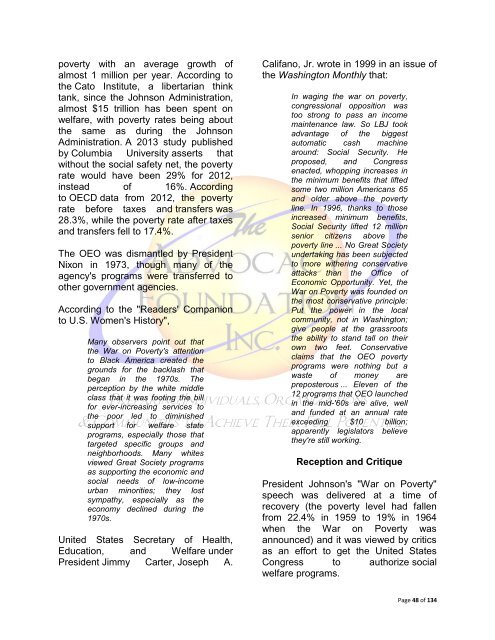Concentrated Poverty
Concentrated Poverty
Concentrated Poverty
Create successful ePaper yourself
Turn your PDF publications into a flip-book with our unique Google optimized e-Paper software.
poverty with an average growth of<br />
almost 1 million per year. According to<br />
the Cato Institute, a libertarian think<br />
tank, since the Johnson Administration,<br />
almost $15 trillion has been spent on<br />
welfare, with poverty rates being about<br />
the same as during the Johnson<br />
Administration. A 2013 study published<br />
by Columbia University asserts that<br />
without the social safety net, the poverty<br />
rate would have been 29% for 2012,<br />
instead of 16%. According<br />
to OECD data from 2012, the poverty<br />
rate before taxes and transfers was<br />
28.3%, while the poverty rate after taxes<br />
and transfers fell to 17.4%.<br />
The OEO was dismantled by President<br />
Nixon in 1973, though many of the<br />
agency's programs were transferred to<br />
other government agencies.<br />
According to the "Readers' Companion<br />
to U.S. Women's History",<br />
Many observers point out that<br />
the War on <strong>Poverty</strong>'s attention<br />
to Black America created the<br />
grounds for the backlash that<br />
began in the 1970s. The<br />
perception by the white middle<br />
class that it was footing the bill<br />
for ever-increasing services to<br />
the poor led to diminished<br />
support for welfare state<br />
programs, especially those that<br />
targeted specific groups and<br />
neighborhoods. Many whites<br />
viewed Great Society programs<br />
as supporting the economic and<br />
social needs of low-income<br />
urban minorities; they lost<br />
sympathy, especially as the<br />
economy declined during the<br />
1970s.<br />
United States Secretary of Health,<br />
Education, and Welfare under<br />
President Jimmy Carter, Joseph A.<br />
Califano, Jr. wrote in 1999 in an issue of<br />
the Washington Monthly that:<br />
In waging the war on poverty,<br />
congressional opposition was<br />
too strong to pass an income<br />
maintenance law. So LBJ took<br />
advantage of the biggest<br />
automatic cash machine<br />
around: Social Security. He<br />
proposed, and Congress<br />
enacted, whopping increases in<br />
the minimum benefits that lifted<br />
some two million Americans 65<br />
and older above the poverty<br />
line. In 1996, thanks to those<br />
increased minimum benefits,<br />
Social Security lifted 12 million<br />
senior citizens above the<br />
poverty line ... No Great Society<br />
undertaking has been subjected<br />
to more withering conservative<br />
attacks than the Office of<br />
Economic Opportunity. Yet, the<br />
War on <strong>Poverty</strong> was founded on<br />
the most conservative principle:<br />
Put the power in the local<br />
community, not in Washington;<br />
give people at the grassroots<br />
the ability to stand tall on their<br />
own two feet. Conservative<br />
claims that the OEO poverty<br />
programs were nothing but a<br />
waste of money are<br />
preposterous ... Eleven of the<br />
12 programs that OEO launched<br />
in the mid-'60s are alive, well<br />
and funded at an annual rate<br />
exceeding $10 billion;<br />
apparently legislators believe<br />
they're still working.<br />
Reception and Critique<br />
President Johnson's "War on <strong>Poverty</strong>"<br />
speech was delivered at a time of<br />
recovery (the poverty level had fallen<br />
from 22.4% in 1959 to 19% in 1964<br />
when the War on <strong>Poverty</strong> was<br />
announced) and it was viewed by critics<br />
as an effort to get the United States<br />
Congress to authorize social<br />
welfare programs.<br />
Page 48 of 134

















